I have just realised how many of the flowers in the garden at the moment are either yellow or purple. It was not intentional. These perennial sunflowers were only used as a temporary filler to separate me from the next garden where I am creating a new border where trees have been removed.
I have enjoyed them so much and they have survived so well in this extra hot year that they have won their place to stay.
The Verbena bonariensis work well with them and I am finding more self-seeded babies that I will mix with them for next year.
The sunflowers provide the perfect backdrop for my Salvia amistad which are a new addition to my salvias this year.
The Salvia amistad is planted beside the Salvia uliginosa, also in its first year. I saw it last year in a post by the Anxious Gardener but as it is pale blue it is not really allowed in this post.
I could not imagine the Salvia Amistad being such a favourite with the bees but it must contain a lot of nectar as the bees completely disappear down the flower to remain there for some time before emerging looking very self-satisfied.
The bumbles prefer the shorter flowers of the uliginosa but I have seen them find another way to reach the nectaries by pushing aside the sepals like this bee above is doing. Trying to walk down the throat of the flower is not an option for the fat bumble bees.
My Cosmos sulphureus was also an after thought this year and I put the seeds down late into any space that had a patch of soil vacant.
Their bright patches are a magnet for all sorts of bees and some are already setting seed which I will leave for the birds to feast on. I will also be keeping enough seed for next year too as these ideal fillers and brighteners.
My blue (they look purple to me) geraniums are starting to emerge from where the hot sun has been keeping them at bay. These are the true geraniums and provide pollen for the bees, not like the stiff pelargoniums that are frequently grown as potted plants over here but have no attraction for bees or pollinators.
I have a Clematis “Korean Beauty” growing at the moment. My sister, who loves clematis, gave me the seeds which I have dutifully germinated. I find clematis infuriating as I try to guide them to a more upright orderly pattern but they usually end up forming tangled balls of untidy growth. Then when I try and sort them out I end up snipping the wrong stem and finish with a flowering spray of clematis in one hand and a stunted looking plant left in the ground.
However, Korean Beauty has won her place in the garden because the bees love her and I like watching their antics as they search for the nectar. The bumble bee above could hardly wait for the flower to open so that it could get first in line for the nectar.
My first sowing of Phacelia in the vegetable patch has finished. It has stood guard over the saffron and kept the area virtually weed free. Now I am waiting for the saffron shoots to appear.
The experiment worked so well that I have sown another patch on the vegetable garden where some lettuce and greens have finished. It is fun to watch the bees with purple pollen.
I have been thinking about native flowers and although I try and pull out as much of the Mallow sylvestris that I can, I wonder if I am being too harsh. It can be very invasive but perhaps I should find a legal corner for it.
I did sow some common Fleabane (Pulicaria dysenterica) last year because of its attraction for pollinators but time will tell if I will regret doing this.
My tradescantia has just started to flower for the second time this year with its purple petals and yellow tipped stamens. And I must not forget to mention the little purple flowers of the nepeta pushing into the picture from the side. The nepeta is a real workhorse of a flower for a hot dry garden and has, of course, purple flowers.



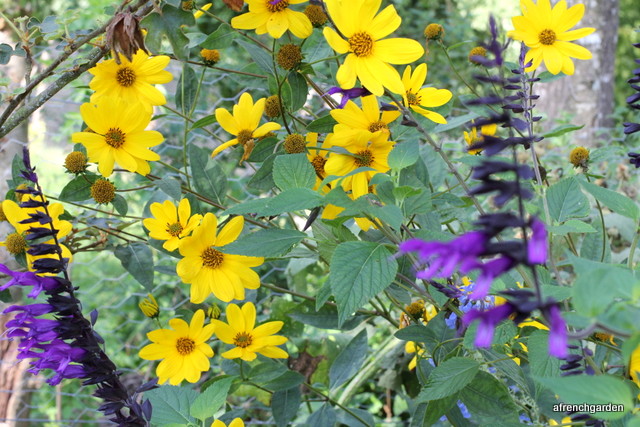
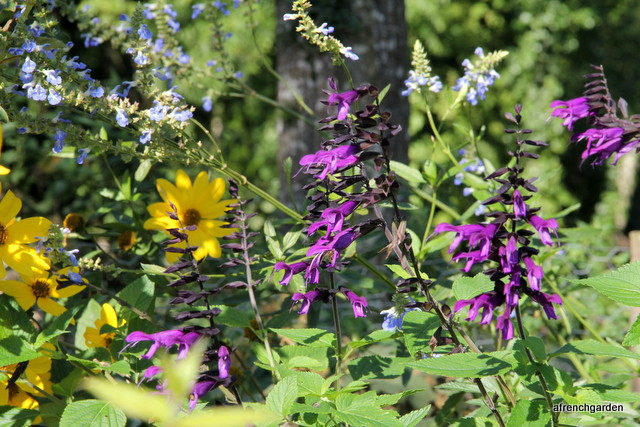
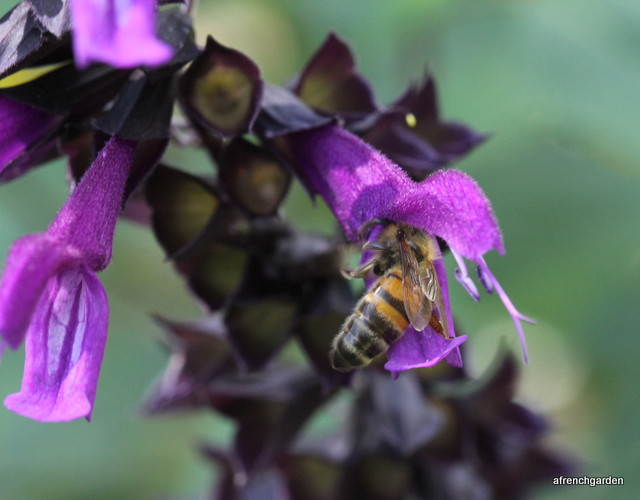

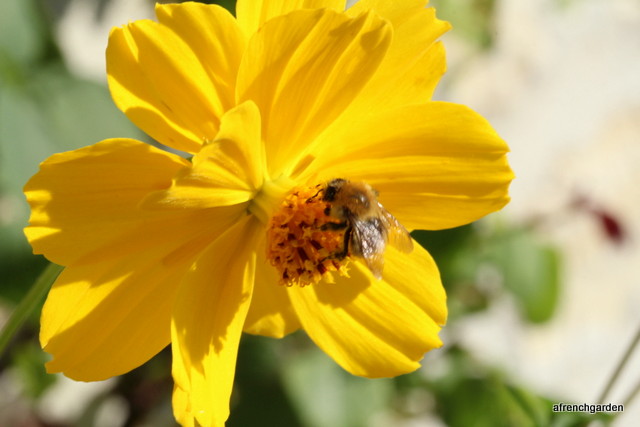

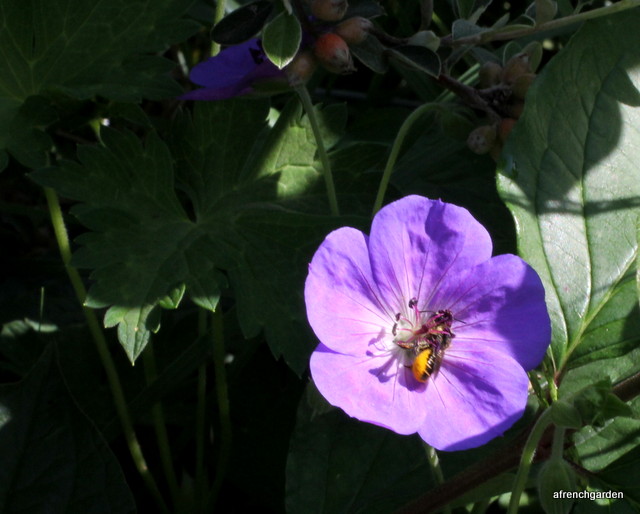


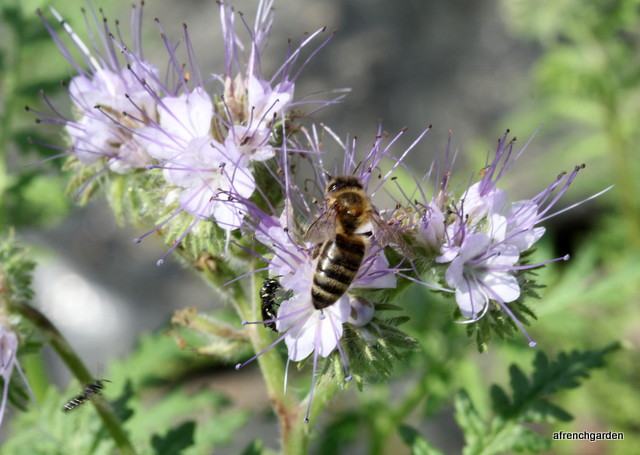

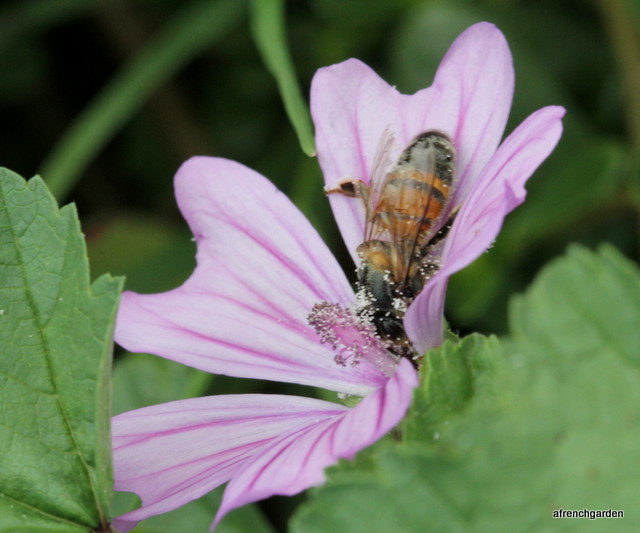

Your garden looks a really happy place to be Amelia, I always think those ‘blue’ geraniums look more purple too. Cosmos sulphureus looks lovely, I grew Cosmos ‘Purity’ this year a white form but have just added ‘sulphureus’ to my list for next year.
LikeLike
It is really handy to have some Sulphureus seeds at the ready if you have a bare patch coming up towards the end of the year. They are great fillers. Amelia
LikeLiked by 1 person
Your garden still looks very summery, here it feels very autumnal and I dont see as many flowers which means fewer bees.
I enjoyed your bee pictures.
LikeLiked by 1 person
Thank you. The weather here has continued hot which let us get away for four days to the Correze. The weather has just turned and rain is forecast for the rest for the week which makes us feel very smug about the timing of our break. Amelia
LikeLike
Your orange Cosmos is lovely. I grew several types this year, most of them brilliant but the slugs ate my orange ones! Must try again next year.
LikeLike
It has been so hot and dry this year that I have not been bothered by slugs, I suppose that is some compensation. Amelia
LikeLiked by 1 person
It is interesting that late summer is more about bright colours to attract the bees, rather than the strong perfumes of winter and spring. It is ingenious how bees can find their way into difficult flowers. I had very large Datura, the flowers of which open at dusk, but the bees couldn’t wait to get into the flower and so made holes in the base of the bud so they could get at the nectar.
LikeLike
So colorful. So beautiful. Thanks for sharing.
LikeLike
The hot dry autumn is making the colours more vivid I think but now we have a wet week forecast. Amelia
LikeLike
Pleased you’re growing uliginosa, Amelia – one of my favourites. There is something very satisfying about having insects feed on plants you’ve grown. D
LikeLike
I thought it would fit in well here when I “saw” it in your garden and the bumble bees have welcomed it with open wings. Amelia
LikeLiked by 1 person
Your garden is certainly bee friendly and you have so many lovely blooms. I noticed this year that Phacelia smells lovely too, so well worth growing.
LikeLike
I like its mild perfume too. It is all these different perfumes mixing that make gardens smell so good. Amelia
LikeLike
The flowers are beautiful. I’ve never heard of the Korean Beauty clematis. It has unusual but pretty flowers.
LikeLike
I prefer the smaller clematis and then they usually have the pretty seed heads too. Amelia
LikeLike
Very handy catalogue of bee-kind flowers, Amelia. I’d forgotten about mallow, which I love. Mrs RH does not. We don’t have any! RH
LikeLike
I might try one next year if I can get it to climb up and not smother all that surrounds it. Amelia
LikeLike
Clematis “Korean Beauty” is very aptly named. I have not seen a yellow Cosmos before, can I ask, where did you source the seed from?
LikeLike
I’ve grown it for so many years I cannot remember where it originated from. I have a feeling it was from a local garden. It grows very readily from seed and performs best in full sun. I get mainly deep yellow flowers but also some bright lemon ones that I like very much. I separate off the lemon seeds but they don’t breed true but perhaps that’s what makes them feel special to me as they are in the minority. I could easily send you some as I get masses which I leave on the plant for the birds. Drop me an email if you would like some. Amelia
LikeLike
I would love some seeds, thanks. I couldn’t find a contact form on the blog.
LikeLike
It’s afrenchgarden@gmail.com. Amelia
LikeLike
I’m envious of your Phacelia. Mine was growing well until the deer found it. (I can’t deer proof everything). You’ve got so many flowers that are still blooming. Nice going!
LikeLike
We do have deer around here – the little roe deer- but thank goodness the usually stay out of the garden. Amelia
LikeLiked by 1 person
What a beautiful garden. I always think of the purples and yellows as spring flower colours.
LikeLike
I agree with you but this year the garden is looking exceptionally bright rather than “autumny”. Amelia
LikeLiked by 1 person
Yellows and purples are glorious colours for autumn – purple for those misty morning skies and yellow for late sunshine. Your garden is a heady place for bees and butterflies, I’m keeping your list of late flowering bee-pleasers to plant in our garden for next year.
LikeLike
I keep a plant “wish list” and I make a note if I see a mention of any plants or flowers that are bee friendly when I read blogs. When I visit the UK I have it handy when I visit nurseries. Very little gets planted now without the bees in mind. Amelia
LikeLike